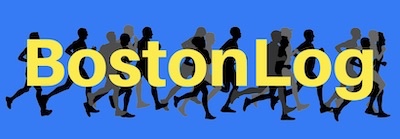About a month before the marathon, I started to taper down my caffeine intake so I’d have had a caffeine-free diet for the last couple of weeks before the marathon, and on marathon morning, I’d be able to take a big jolt of it to improve my running. I went from full-caffeine coffee to half-caff for a week, then quarter-caff for a few more days, then nothing. Our bodies are amazing things: I was just getting into the quarter-caff stage when I had developed a craving for very dark chocolate, which I started to eat. Of course, the theobromine in chocolate is very similar to caffeine, and I luckily figured that out and dropped chocolate after a single bar. Anyway, I was caffeine and chocolate free for the last couple of weeks.
My wife Ellyn and I got to Boston on a flight that got us to our hotel at almost midnight Friday night. The marathon is always held on Monday, “Patriots Day”, to commemorate Paul Revere’s ride in 1775. It’s a city-wide holiday. The race starts in the small town of Hopkinton, which is 26.2 miles from the finish, and the course goes through a whole series of suburbs before the last two or three miles in the city of Boston proper.
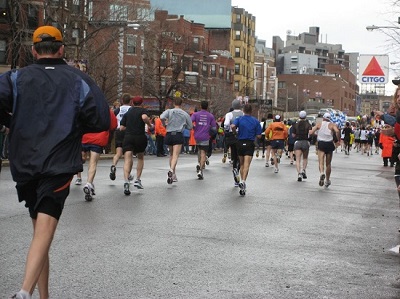
The main topic of conversation for the entire weekend was the weather. It was supposed to be the worst weather ever for the marathon. The most pessimistic prediction was for temperatures in the low 30’s, heavy rain (three to five inches) and howling headwinds from 30 to 50 miles per hour, all aimed directly at the runners. Rumors were flying everywhere, and by asking around, you could hear any version you wanted, from still blacker predictions to pollyannaish wishful thinking. There were email warnings about hypothermia, where to find the medical tents, completely paranoid descriptions of what to wear, et cetera. [I’ve included below a copy of what we received.] None of the actual runners I talked to had any intention of backing out, since after all, it IS the Boston Marathon. Lots of non-runners were far more worried than the crazy runners.
On Saturday morning we went to the big marathon expo, bought tons of junk with the “Boston Marathon” logo on it, checked in, and got my bib number and “chip.” The “chip” is a little RFID device you tie to your shoe with your shoelaces, and it’s totally passive (no batteries) until you sweep it through a magnetic field. There’s a coil or something in it that, when swept through a field, generates a surge of current in the chip that causes it to transmit a unique number that’s picked up by a receiver on the ground. At various points along the course (start, finish, every 5K, and at the half marathon point) there were chip pickups, so the progress of the runners can be recorded. The key points are the start and end of the race, and since the start is pretty crowded, the fact you pass the starting line possibly many minutes after the starting gun is not a disadvantage: your official time is your finishing time minus your personal starting time. This arrangement of pickups also helps prevent cheating as occurred in the Rosie Ruiz case many years ago when a relatively unknown woman runner appeared to win, but it turns out she rode on the MBTA system (more about that later) for a good chunk of the run.
This year the results of the chip pickups were available on the internet, so friends could log in and using your bib number, track your progress along the route. Finally, you could specify up to three devices (internet addresses or portable devices) and your particular results would be transmitted as alerts to let the people at the other end know when you had passed the 10K, half-marathon, and 30K points.
We knew two people in Boston, and planned to meet with both of them.
On Saturday we got a great tour of MIT from a friend I hadn’t seen in years, including his lab, where they’re building a driverless car to compete in the DARPA competition in November. It was unbelievable how much computer hardware was crammed in the back seat, and the entire outside of the car was covered with sensors: cameras, laser range-finders and radar to help the car sense its location. My friend is in charge of the sensing, and others are in charge of other parts of the vehicle.
It was a rest day for me, so we tried to minimize walking, but we did go to the MIT museum when my friend had to go home, and that was amazing, too: all sorts of robotics stuff, amazing tech-art, and historical stuff. We decided to try the “T” (the MBTA: Boston’s subway system, made famous by the Kingston Trio’s “Charlie on the MTA” song about a guy who gets stuck on the subway due to a fare increase and can’t pay to get off — you know: “Charlie handed in his dime at the Kendall Square station and he changed for Jamaica Plain. When he got there the conductor told him ‘one more nickel’: Charlie couldn’t get off of that train…”). The tickets today are called “Charlies.” It seems like a great system, heavily used, and easy to use. We stepped on the first train and were suddenly face-to-face with the third person in the world we know in Boston. Pretty amazing coincidence! We hadn’t seen her in years. She’s not a close friend, but it was fun to see her, and we talked until she had to get off.
We had a giant dinner that night at the hotel buffet and went to bed. A funny thing about it being marathon weekend is there were skinny people all over the place, all wearing old running shoes. Even in the nice restaurants, people were nicely dressed, but wearing running shoes. It was pretty easy to guess, a lot of the time, which folks were getting ready to run.
The next day there was a “fun run,” open to anyone, through the historical parts of Boston, which finished at the real marathon finishing line. We looked out of the hotel window to check on the weather and it was snowing: just a few flakes, but definitely snow. I decided to go anyway. The fun run was about 2.5 miles long, and about 3,000 of us showed up to do it (marathon runners plus their friends and families). There was free entry, but they did supply a T-shirt, racing bibs, and all the usual post-race stuff: food to eat, water, giveaways, et cetera. It was fun: they had a line of people at the front from one of the Boston running clubs, and the rule was you couldn’t pass them, so it really was a fun run. I ran it at a 10:30 pace, and the rain started at the same time as the fun run.
Then we had brunch with a friend from California who was also going to do the race. We ate at “Legal Seafood”, stuffed ourselves, and decided to go out and look over the finishing line so our wives would know where to go to watch the race. We got about 50 feet outside the door and bailed, because of the wind and rain, so we just sat in the hotel lobby and talked about all sorts of random stuff, including the initial flip-flopping about what we were going to wear. We, and I think every other runner, decided not to decide, and basically took everything they had to the start, planning to make the final dress decisions as close to the start of the race as possible.
In the evening, we took the MBTA out past Newton to visit another friend we hadn’t seen in many, many years. We went to a great dinner with her and her kids, stuffed ourselves at a very nice Indian restaurant, and tried to begin to catch up. She volunteered to drive us back to town which was very nice, at which point I went from being mister normal to become mister anal-compulsive: I laid out all the running gear, pinned the bib number of my shirt, tried it on, re-pinned it to get it right, tried it on again, re-pinned it, and it was finally perfect. Then I went over and over the equipment list, made sure it ALL was on a chair, set three alarms for 5 AM, and went to sleep.
My plan was to wear a long-sleeved lightweight shirt, shorts, but with tights over them that I could take off if it looked warm, gloves (I took two pairs: one lightweight, and one medium weight that included windbreak covering that could go over the fingers if it was cold). I took two hats: my regular running cap, but also a lycra “skull-cap” that’s much warmer. I had a pre-race windbreaker jacket and matching pants, my heart-rate monitor and chest strap, socks, an extra pair of dry socks to change to if the initial socks were soaked by the beginning of the race, vaseline for my toes and feet, Body Glide to prevent chafing in the armpits, nipples, and between the legs, extra vaseline for the start in case I decided to change socks, and of course a big supply of sports gels that were loaded with sugars electrolytes and the magical caffeine.
When I got up, I changed my mind for the first time and decided not to wear the tights, but to put them in my bag, so I could pull them on just before the race if that seemed the right thing to do.
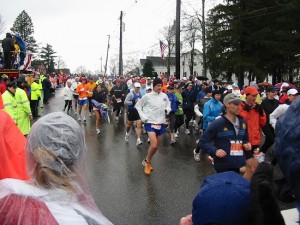
The race had a staggered start: the elite women started at 9:30, the faster men at 10:00, and the rest of us at 10:30. The bib numbers are assigned in order of your qualifying time and we all were to begin in “corrals” corresponding to our bib numbers. There were about 25,000 entrants, with the fastest qualifying time having bib number 1, and so on. Mine was 14420, so I was to begin in corral 14, with about 999 other runners who go at about my speed, ahead of the 15’s, but behind the 13’s. It’s a great system: you don’t need to pass too many people, and not many need to pass you at the beginning when things are horribly crowded.
My qualifying time was 3:38, which amounts to about an 8:20 minutes per mile average pace. I was hoping to go faster than that — maybe even a 3:30 time, and I’d been working with a coach (named Lisa: see below) for a couple of months to see what I could do. To hit 3:30, I needed to run the miles significantly faster: about an 8:00 pace.
All the busses from Boston to the race start in Hopkinton met the runners at the Boston Common, about 3/4 of a mile from the hotel, and I was supposed to pick up my bus between 6:30 and 7:00. It was a little discouraging to step out of the hotel into a huge blast of wind that nearly ripped my hat off as I stepped out the door. There was rain and wind all the way to the bus pickup point, and when I got there, there were long lines. They would make a line of about eight or ten busses, each with its own line of people trying to get on, they’d fill all the busses, and then all would take off. I got on the third set of busses, and had a Canadian gal named Heidi as a seat-mate who was pretty entertaining. Mostly on the way out to Hopkinton, we talked about the major topic of the morning: what the weather was going to do and what we were going to wear.
When we finally got to the staging area (a high school in Hopkinton) we first tried to get into the gymnasium, but it was full and there were fire marshalls to keep it from getting too full. Next we tried the nearest of the giant tents set up on the athletic field. There were bagels and coffee in the tent, so we ate some of that, and then tried to find a place to sit down. Basically every square inch was covered, so we went to the second tent down below the track, and it was NOT full, but for good reason: the ground had flooded, and there were two or three inches of mud on the ground. That didn’t look like it would be much fun, so we went outside and found the wall of a building to lean against that protected us somewhat from the wind and rain, and we waited there from about 7:30 to 10:00, getting colder and colder as the time went on.
In spite of the cold, it was sort of fun, since misery loves company and all the other people sharing our wall were in the same position. To pass the time we had a sort of a contest about who could make the most depressing, blackest observation about our condition. We also spent a large proportion of the time talking about what we were going to wear. Although we were getting colder, the weather itself did seem to be improving somewhat, and from time to time, you could see a brighter spot in the clouds indicating the sun might be somewhere behind. Every mention of a possible clothing strategy was prefaced by “I reserve the right to change my mind 20 more times, but …”
At about 10:00 we finally had to commit to clothes, and I decided to go lightweight: a thin, long-sleeved jersey, running shorts, and running hat. I had a big black garbage bag I tore holes in for my head and arms and wore that to the start. My shoes and socks were completely soaked, but I decided not to change them for dry socks since I was sure they’d be soaked within a mile or two, so why bother? I’d done a lot of running in wet shoes and socks and never had any problems.
As I changed clothes, I also took on a huge load of caffeine: about 200 mg, assuming the labels on the gel packages were true. There was certainly some caffeine in there — I was quite wired and talking a mile a minute as we walked from the high school to the start. I was also carrying with me two more 100 mg “doses” in the form of Clif “Double Espresso” gel packs, each of which also included about 125 calories in sugar.
I stuffed everything else into my numbered race bag and checked it in. Then we started the 3/4 mile walk from the high school to the starting corrals. I figured I’d do a last-minute toilet stop, and that was the last I saw of Heidi. There were only about four people ahead of me in the toilet line but I got out at 10:25 and jogged to my corral, which I climbed into with less than a minute before the starting gun.
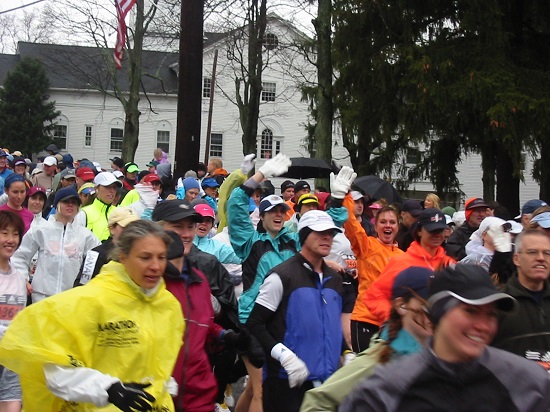
It took four minutes from the gun until I reached the starting line, and I was pleased that although it was crowded, I could go at a pretty good pace right from the git-go. I missed taking a lap time at the first mile since I was still pretty busy dodging bodies, but I’m pretty sure it was at about 9:00 minutes. (All the times below are relative to my starting time, four minutes after gun time, since I started measuring my time as I crossed the line, not when the gun went off.)
I ran wearing the garbage bag for the first two miles, but the instant I felt warm enough, I stripped it off and discarded it. The last thing I wanted to do was overheat. The first few miles of the course were completely littered with discarded clothing: not just garbage bags, but ponchos, hats, gloves, and even some jackets. Most was pretty used, and I’m sure a lot of folks run with the full intention of abandoning clothes as things heat up. It’s a real pain to carry stuff for 20 miles.
I figured I’d at least start at roughly an 8:00 minute pace (which would give me a 3:30 finishing time) and then I’d back off a little if it seemed too fast. Starting at about Mile 3, I was basically locked in at 8:00. I managed to pick up about 20 seconds from my 9:00 first mile, and so for many miles the times looked like 24:40, 32:40, 40:40, …plus or minus a couple of seconds, at each mile marker. I didn’t run with anyone, since at the beginning, I was with runners who had qualified at about 8:20 miles, and even then, my qualifier was on a tougher course than most, so I was gradually passing lots and lots of people.
I took on Gatorade or water at about half of the official rest stops which were located near every mile marker. I was not methodical about whether I took one or the other – I just grabbed whichever one seemed most attractive at the time. At Mile 10 and again at Mile 16 I took the two final caffeine+sugar jolts.
My coach had suggested I try repeating a sort of “mantra” every mile or so, possibly swapping mantras each mile. It sounded like a good idea, so the ones I used were “Smooth and strong,” “Light on your feet,” and “Form and relax.” The final one made me think about my running form in particular, and the “relax” part was in reference to my upper body, where I often wind up carrying tension in my neck, shoulders, and arms. It was a good suggestion, and until about Mile 22 I did it a lot, although I never did it for more than a few hundred yards at a time. Also, I never stuck to one mantra: I’d go through all three each time, which was helpful. I usually didn’t have many corrections to my form, but the “relax” was really a good idea. Every time I did that mantra, there was tension to remove.
The crowds were great, but I don’t remember much about the course: things were wet, it was a little crowded all the way to the end, and I didn’t want to slip or run into anybody. I was still pretty close to an 8:05 overall pace by the time I got to Wellesley College which is at about the half-way point. That part of the race is unforgettable: the Wellesley girls are all screaming their heads off, and it’s the best cheering section on the course. Lots of them were carrying signs that said “Kiss me!” but the sign I liked the best was “Run bitch!” I’m sure for a few hundred yards, my pace was down to 7:30 or so…
I was really worried about an accident toward the end of the race. You’re so tired you know you can’t react quickly. If somebody steps out in front of you suddenly, it takes a long time to react and it’s easy to have a collision. The runners all know this instinctively, so they are highly predictable, but most of the spectators at Mile 23 haven’t a clue about how f**ked up we are, and will suddenly decide they need to dash across the course for a better vantage point. When this happens, the dulled minds of the runners spring into action (about three seconds later) and then their rudder slowly starts to turn, like steering the Titanic. I saw a few spectator – runner collisions, but managed to avoid them myself. The course was pretty well staffed with folks who helped keep the crowd from doing much.
I was feeling tired, but not bad at all. I had kept my heart rate completely in control, usually from 150 to 155 bpm. Because of all the training I’d done, I knew I could maintain that level of exercise for as long as necessary, and by about Wellesley, I was sure I’d at least re-qualify for the Boston marathon the next year. (For people my age, all I needed was to finish in 3:45, which amounts to about an 8:34 pace.) Since I’d gained, on average, 30 seconds per mile, at the half-way point I had an “extra” 30×13, or 390 seconds I could “waste.” I slowed down a little for the next couple of miles, but only to about an 8:10 pace, so I was still putting time in the bank toward re-qualifying.
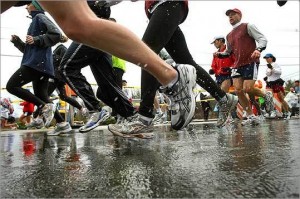
But at Mile 16, the wheels started coming loose, and at Mile 18, they fell off. At Mile 16, my calves started to feel like they might cramp and at Mile 18 they started to do it. Every few hundred yards, they’d seize up, and I’d come lurching to a stop. I’d walk a couple of steps, and then start running again. I found when I was going fast, the cramps came faster, but if I slowed down, the cramping problem decreased a lot, but wouldn’t go away. I finally wound up running for most of the last eight miles at about a 10:00 to 10:30 pace, with just a half-dozen or so times I had to stop and walk, or try to stretch out the calf muscles. Unfortunately, even with all my time “in the bank,” this was blowing between 90 and 120 seconds per mile: I was “withdrawing” it a lot faster than I had put it in.
It was pretty depressing. I had plenty of power, and in fact, my heart rate went down as low as 120 bpm for the last miles, but every time I tried to speed up, the severe cramps started again. My engine was working fine, but the transmission was broken. It became clear by about Mile 22 I’d not even qualify, and I finally finished in about 3:51, while I needed a 3:45 to qualify for next year.
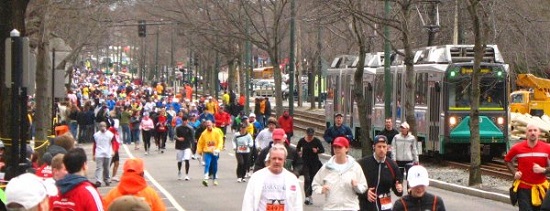
After the race, I talked to lots of folks who had had similar problems. It was probably just due to the cold, I guess, and maybe in my case due to all the chilling before the actual start. There were many more people doing short walks toward the end of the race than I’ve seen at other races, and although I couldn’t diagnose the problems, maybe a lot of them were suffering from cramps.
Everything was fine after the finish, except for the recovery of the bags we’d checked in Hopkinton. Each of our bags had our bib number printed on it, and we pre-sorted them at Hopkinton: the school busses we’d ridden to the start were used to transport the bags back and each window had a range of numbers on it, like 14400-14450. Thus at the end you found your bus and your window and somebody on the bus would find your bag. Unfortunately, we had a very stubborn person handing out bags at our window. It was clear that almost all of us had finished, but she insisted on collecting a number and then searching through the bags for that particular one, so at the beginning, she’d have to search through up to 50 bags. If she’d just pulled bags at random and called out numbers, 95% of the time there’d be the right person there to get it; 5% of the time she’d have to try another bag. The window next to her did it that way, and unloaded bags at least three times as fast. We kept trying to convince her to change, but the more we tried, the more stubborn she got, and we were perhaps not the politest people around: tired, and chilled and hungry and cranky, and ready to get off our feet. Finally, after waiting what seemed like forever, I got my bag, walked to the family meeting area, and found my wife Ellyn.
We hiked (very slowly) back to our hotel, and it was weird to see the lobby completely jammed with people. We went to the elevator and found out why: the elevators weren’t working. There’d been a false alarm, the elevators automatically shut down, and the firemen hadn’t been able to get them working, so they’d called the alarm company. Luckily, we were only on the eighth floor, and escalators went up to the fourth, so I only had to climb four flights of stairs. Those four flights were bad enough: I’m sure glad our room wasn’t on the fortieth floor!
After soaking in a bath for a while, I felt OK, and we hiked four or five blocks to meet with another friend from California who had done the race for a great meal in a French restaurant.
While typing most of this account on the plane ride home, it was amazing how many healthy-looking people were having a hard time walking, or getting up, or sitting down…
Here are my times at various distances during the race, measured by my chip:
5k: 0:25:31
10k: 0:50:27
15k: 1:15:36
20k: 1:41:24
Half marathon: 1:47:01
25k: 2:07:39
30k: 2:34:40
35k: 3:04:02
40k: 3:38:31
Finish: 3:51:48
That gave me these 5k splits:
0:25:31
0:24:56
0:25:09
0:25:48
0:26:15
0:27:01
0:29:22
0:34:29
The first five were pretty good, and the 27:01 wasn’t terrible…
So, good news and bad news. I was able to hold a significantly faster pace than I have for many years. The end was really annoying, since I was having no cardio problems, no pain anywhere, except for the stupid cramps. In spite of the weather, I look forward to running Boston again. I had a great time anyway – great crowds, friendly runners, great volunteers and support.
Tom Davis
Los Altos Hills, California
April 16, 2007
Age – 57
Bib # 14420
3:51:48
[Visit Tom Davis’s home page Geometer.org, which chronicles two of his three Boston races, as well as his many birding adventures ]
Weather warning from the Boston Athletic Association:
April 13, 2007
Weather Advisory – 2007 Boston Marathon
The Boston Athletic Association’s medical team recommends the following precautions and advice for participants in Monday’s Boston Marathon:
FORECAST:
The most up-to-date weather forecast calls for a predicted Spring storm on Monday, including heavy rains (potentially 3 to 5 inches), with the start temperatures in the mid to upper 30’s. Wind will likely be East (in the face of the participants for most of the race) in the 20 to 25 mile per hour range, with gusts to as much as 50 miles per hour. This will produce a wind chill index of 25 to 30-degrees Fahrenheit.
RISKS AND RECOMMENDATIONS FOR RUNNERS PARTICIPATING IN COLD AND WET CONDITIONS:
Combined with the rain, we are concerned that predicted weather conditions will increase the runners’ risks for a condition called hypothermia. As with any athletic competition, as a runner you are assuming the risks inherent with participation. It is your responsibility to be informed about the risks associated with running in the aforementioned conditions, and the risks of injury or illness will increase with these predicted conditions.
While exercising in cold weather, our bodies attempt to maintain core temperature by shunting blood away from the periphery, thus minimizing heat loss. Hypothermia sets in when the body’s temperature drops below normal, starting when the body loses heat faster than heat can be generated. Heat is produced by muscle action and shivering. Very low body temperatures can be life threatening.
WARNING SIGNS OF HYPOTHERMIA:
Mild hypothermia is heralded by goose pimples and shivering as our bodies attempt to raise our metabolic rates to increase our core temperature.
Moderate hypothermia will result in muscular fatigue, poor coordination, numbness and disorientation.
Severe hypothermia can result ultimately in cardiovascular failure. Treatment of hypothermia requires prompt recognition and treatment as mild hypothermia can progress to a more severe situation if not addressed early.
WHAT TO DO IF HYPOTHERMIA SETS IN:
Runners should be removed from cold, wet, or windy conditions. Wet clothing should be removed, and rewarming commenced with warm blankets and ingestion of warm fluids. If the athlete’s condition does not improve, transportation to a medical facility should be arranged. Hypothermia can occur at temperatures at, or below 45 degrees Fahrenheit, or even in higher temperatures when the weather is also wet and windy. Cold temperatures, dampness, and wind increase the risk of hypothermia for runners. Sweat cools the body quickly during cold weather running. Wind evaporates it faster.
As with so many other conditions in sports medicine, our best offense (treatment) is a good defense (preparation). Following the guidelines below will help minimize risk for cold related illness and will maximize your enjoyment and performance during the race:
PRACTICAL ADVICE FOR RACE DAY:
1. Be prepared prior to the race. Have extra clothing which will enable you to stay dry even before the race begins.
2. For the race itself, dress in layers of loose, lightweight clothing. The first layer of clothing (closest to the body) should be made of polyester or polypropylene which will “wick” sweat away from the body. Subsequent layers should be loose and breathable-fleece is a good choice. Cotton should be minimized as it can allow sweat buildup. The outer layer should be wind and water resistant, thus protecting from wind, rain, and snow. When in doubt, add the extra layer. You can always remove a layer if you warm up, but you will regret not having it if you start freezing with several miles to go.
3. Protect your head and extremities. Wearing a hat is essential as up to 50% of body heat can be lost though the head. Gloves are important to prevent exposure to the hands. These, too, can be removed if you get warm, but you’ll regret not having them if needed. Mittens are better on colder days as they will keep the hands even warmer. Shield the face with a scarf or high collar. Wear socks that retain heat and wick moisture away.
4. Runners with exercise-induced bronchospasm should attempt to warm air such as through a scarf or mask. A prolonged warm-up prior to hard running can help minimize symptoms. Carry your inhaler if you use one, and use it should it become necessary.
5. Stay with your normal hydration regime, remembering not to over drink. Do not drink alcohol the night before the race. Alcohol will make the body lose heat faster.
6. Run with a partner. It is sometimes difficult to recognize if you are becoming hypothermic. A running partner can help if you get into trouble. Shivering is a sign of hypothermia. The cessation of shivering may indicate more severe hypothermia and the runner should seek evaluation at a shelter.
7. Consider canceling your run or seek shelter if the weather conditions are too severe or you are too tired. Running on ice or over snow-covered terrain can lead to tripping, falling, or injury.
8. Medical stations and American Red Cross locations – located every mile along the route – along the course will have buses to handle your medical needs. Rewarming will be difficult given the weather and normal field size, so if you are not feeling well, do not wait to seek medical attention.
9. Help each other. Be aware of yourself but also make medical team members aware if you see someone on the route who you believe may be starting to suffer from the onset of hypothermia.
TREATMENT OF HYPOTHERMIA
Keep the runner dry and cover with blankets.
Shelter the runner from wind and water.
Provide heat to the neck, underarms, and groin. Heat only the trunk initially to avoid core temperature after-drop. After-drop occurs in this manner: Extremities cool faster than the trunk. If you re-warm the extremities, their colder blood will re-enter the circulation and actually worsen hypothermia temporarily.
Keep the runner lying down, but only in a warm dry location.
Administer warm fluids by mouth if the runner is shivering. If the shivering reflex is lost, a bear hugger should be utilized (loss of the shivering reflex signifies significant hypothermia).
Avoid moving/jarring the runner suddenly because this may trigger an abnormal heart rhythm.
If CPR is necessary, resuscitation should not be stopped until the person’s body temperature is at least 95¡F/35¡C (never give up your efforts). All temperatures indicated are rectal measures, which give a closer indication of core temperature. If the victim is cooperative, you may take temperature by other methods.
